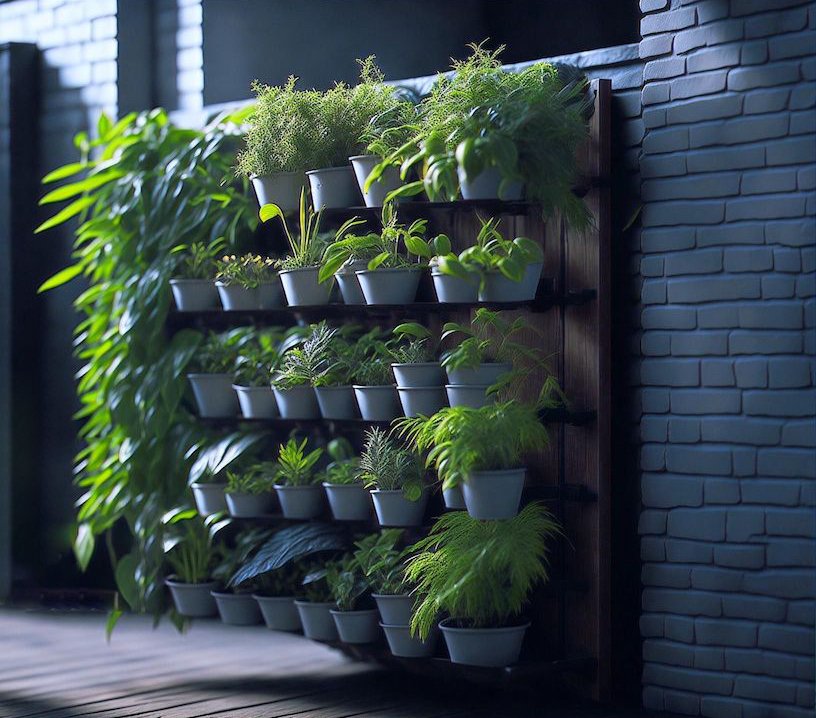Vertical Herb Garden Design
One type of herb garden design that does not occupy too much space and can accommodate several herbs is a vertical herb garden design. No matter which type of herb garden design you are going to choose for your garden, there is one thing that I am very sure of. You will have direct access of fresh herbs all year round, which you and your whole family can gain health benefits from all your herbs from your herb garden.
Key Points:
- Vertical herb gardens efficiently use limited space to grow multiple herbs with shallow roots like thyme and sage.
- A sturdy, waterproof framework provides essential support for soil and plant roots in a vertical design.
- Carefully pouring water over the vertical garden allows it to flow through the plants down to the roots.
- Fast-draining, moisture-retentive soil is ideal to prevent oversaturation in a vertical herb garden.
- Frequent harvesting encourages steady regeneration of herbs grown in the tight quarters of a vertical garden.
Herb Factors for a Vertical Herb Garden Design
For a vertical herb garden design, there will be limited space for all herbs. Opting for herbs that do not have shallow growing root systems is not advisable to be planted in a vertical herb garden design. Some of the common herbs with shallow root systems that can easily grow and survive in a vertical herb garden design include lavender, sage, basil, tarragon, parsley, thyme, and rosemary. Those herbs mentioned with shallow root systems can easily adapt to vertical herb garden design with restricted root space.
How to Water a Vertical Herb Garden Design
Watering a vertical herb garden design is not complicated, and in fact, it is very simple to do. All you have to do is carefully pour water above the herbs. You do not have to worry about water not being able to reach the soil and the root system, because, as herbs catch the water, it will bring the water downwards to the soil and to the roots.
Vertical Herb Garden Design Framework
One thing about a vertical herb garden design, the framework will serve as a support to both the soil and roots of all your herbs. The framework of your vertical herb garden design should be chosen carefully, since the framework keeps the stability of your entire vertical herb garden design. You should choose a framework that is not only sturdy, but also a framework that can withstand water. Frameworks can be made from wood, metal, or even plastic. If you choose a framework made of wood, make sure that the wood do not rot and is waterproof.

Soil for Your Vertical Herb Garden Design
In choosing the type of soil you are going to use for your vertical herb garden design, it will be best if you go for a soil that can easily drain water, while remaining a little moisture. Peat moss or even regular potting soil can be used in a vertical herb garden, just make sure that you do not over-water your herbs. Once you always keep the soil wet, it will just rot the root systems of your herbs, and it can be the cause for your herbs to die.
FAQ:
What types of herbs work best in a vertical garden?
Herbs with shallow root systems like lavender, sage, basil, tarragon, parsley, thyme and rosemary are well-suited for restricted vertical space.
How do you water a vertical herb garden?
Carefully pour water over the vertical garden and let it flow down through the plants to the soil and roots. The plants help channel the water.
What materials work for a vertical herb garden framework?
Sturdy, waterproof materials like wood, metal, and plastic can all provide good structural support. Avoid materials that may rot.
What kind of soil is ideal for a vertical herb garden?
A lightweight, fast-draining soil that retains a little moisture works best. Peat moss and regular potting mixes are good options.
How much sun should a vertical herb garden get?
Most herbs require at least 6 hours of direct sunlight daily. Make sure to situate your vertical garden in an appropriately sunny spot.
How often should I harvest herbs from a vertical garden?
Frequently harvest up to a third of new leaf growth at a time to encourage steady regeneration. Don’t overharvest.
What are some good vertical garden designs?
Column-like towers, stacked pots, hanging pockets, and wall-mounted panels allow for vertical space utilization.
Where can I find more resources for designing a vertical herb garden?
Check out our Complete Guide to Vertical Gardening for in-depth information on structures, irrigation, suitable plants, and more to supplement your knowledge.